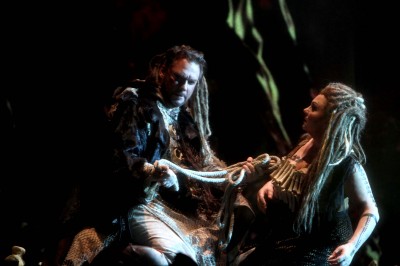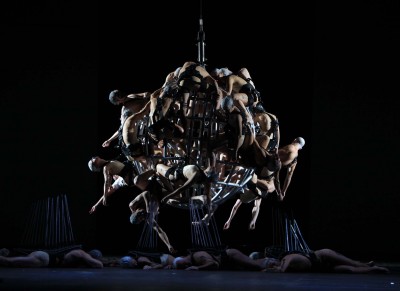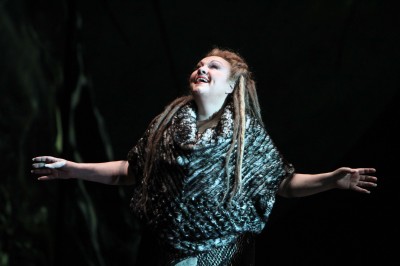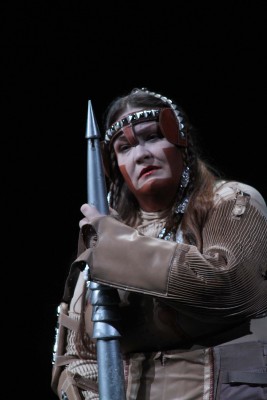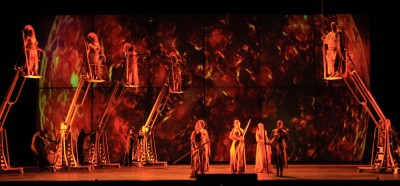DIE WALKÜRE in Florence
Richard Wagner. DIE WALKÜRE, Conducted by Zubin Mehta.
FLORENZE: Florence, Italy, Teatro Comunale. 2013 january 22nd
Review by Fabio Bardelli, photo: Gianluca Moggi, new press photo, firenze
Richard Wagner was born in Lipsia 200 years ago, on May 22nd 1813. After many logistic problems and programme variations, this anniversary is celebrated in Florence with Die Walküre, a revival of the 2007 staging created by the Catalan group La Fura dels Baus as a part of the whole Tetralogy, that we saw in Florence in the last few years.
It’s a pleasure to see again this famous, spectacular and visionary staging after six years; when it was performed the first time, it was sensational for its characteristics which can be found again in the whole Fura dels Baus’ Ring cycle.
.
If something is lacking in this staging is to go deep into the story, a personal view on it and the characters is in fact missing.
. This way of seeing the story, so external, may put on the background the psycological introspections of the various characters. These are the limits of this staging: it discovers nothing new and doesn’t show any new way for future interpreters of this Wagner’s extrahordinary masterpiece.
We remember some of the most impressive scenes of this production: Sieglinde kept by a rope by Hunding and walking on all fours, until she can walk on her legs with Siegmund, the oscillating enormous pendulum with the bodies of dead heroes at the beginning of the 3rd act, and the finale with the fire-circle sorrounding sleeping Brünnhilde, even if a bit different from the 2007 original version staged by director Carlus Padrissa.
Sieglinde was Elena Pankratova, who depicts very well her character on the musical side thanks to her good voice and technique, even if rather foreseeable and not very moving.
Torsten Kerl sings his Siegfried rather well, his voice is not specially strong but well pitched, with a beautiful bronze tone in the middle register and good as interpreter. He has some problems only when he must sing in other registers, far from the center where he gives his best.
Stephen Milling’s Hunding was rough and thundering, just as his character. His performance was very correct and effective, although he didn’t seem to have gone in the depth of the psycology of his role.Juha Uusitalo was Wotan; vocally he’s not in his best shape, and actually his precarious vocality forces him to give almost an intimate rendition of his character, what could also be a way of interpretation. As said, he was exciting in the finale of 3rd act, and he founds deep moving accents in his great scene in 2nd act. Certainly he lacks in that vocal and interpretative strength that would be necessary, but in the whole he depicts very well his character, with excellent phrasing and great intentions.
Brünnhilde was Jennifer Wilson, an intelligent singer even if a bit rough in her vocality
. She had her bad moments but going on with the opera she went much better. However the character was totally welll delineated and the singer was very suitable.
Daniela Denschlang was Fricka, almost a low-key performance, a bit boring too, and not very convincing both vocally and scenically.
In the whole a good performance from all the Valkyries (Bernadette Flaitz, Jacqueline Wagner, Pilar Vázquez, Maria Radner, Eugenia Bethencourt, Julia Rutigliano, Patrizia Scivoletto e Stephanie Iranyi)
.
The evening was a great success, both for the singers, the conductor and the “Furers”, who were wonderful in using the scenical mechanisms and controlling the very silent cranes where the singers had to sing in many moments. The staging has been rather well reprised by Alejandro Stadler and the lights by Gianni Paolo Mirenda, with only some differences from the original production by Carlus Padrissa
. The costumes were of average level, not specially rich in fantasy, by Chu Uroz.As said, the theatre wasn’t sold out, what is a pity and people should regret to have lost the performance. Besides, it was the only Wagner’s opera in Florence in 2013, second centenary of Wagner‘s birth. We hope in a better future for our glorious Florence theatre.
Review by Fabio Bardelli
Translation from italian Bruno Tredicine
Conductor, Zubin Mehta
Regia, La Fura dels Baus (Carlus Padrissa)
ripresa da Alejandro Stadler
Immagini video, Franc Aleu
Scene, Roland Olbeter
Luci, Peter van Praet
riprese da Gianni Paolo Mirenda
Costumi, Chu Uroz
Impianto drammaturgico, Cesare Mazzonis
Siegmund, Torsten Kerl
Hunding, Stephen Milling
Wotan, Juha Uusitalo
Sieglinde, Elena Pankratova
Brünnhilde, Jennifer Wilson
Fricka, Daniela Denschlag
Gerhilde, Bernadette Flaitz
Ortlinde, Jacqueline Wagner
Waltraute, Pilar Vázquez
Schwertleite, Maria Radner
Helmwige, Eugenia Bethencourt
Siegrune, Julia Rutigliano
Grimgerde, Patrizia Scivoletto
Rossweisse, Stephanie Iranyi
Orchestra del Maggio Musicale Fiorentino
Allestimento del Teatro del Maggio Musicale Fiorentino
in coproduzione con Palau de les Arts “Reina Sofía” di Valencia

